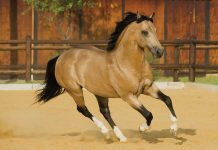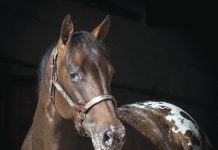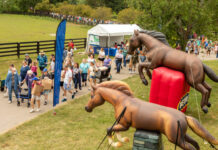Bounce, bounce, bounce! Sometimes trotting can seem very bumpy and fast — especially if the horse has long strides and is extremely springy. But you can’t refuse to ride a horse just because he’s got a bumpy trot, can you? A good rider should be able to ride any type of horse, no matter how high he bounces you out of the saddle. Don’t worry — if you ride a bumpy horse regularly, you’ll soon get used to the up-and-down motion, and ride him like you do any other horse.
Asking for the Trot
Your position at the trot should be the same as at the walk.
- Look in the direction you are going.
- Keep your elbows close to your body.
- Keep your hands even and near to the withers.
- Sit deep in the saddle and keep your back straight
- Stretch your legs down and keep them close to your horse’s sides.
- Shorten your reins slightly.
- Squeeze with your legs several times until your horse trots. Posting to the Trot
Posting (rising) makes trotting more comfortable and less tiring for both you and your horse. When you post, the up-and-down motion of the horse lifts you up out of the saddle naturally. You rise up when one diagonal pair of legs lifts off the ground, and sit down as the same pair returns to the ground. Posting is usually easy unless the horse you’re riding is really bouncy.If you’re finding it difficult to post, count “one-two, one-two” to yourself as your horse moves along. Rise on “one” and sit on “two.” Count until you start to feel a rhythm, then start riding and sitting in time to the horse’s trot.
Diagonals
If you take lessons, you’ve probably had an instructor shout, “You’re on the wrong diagonal!” Whoops! What’s a diagonal? Diagonals are a way of making sure you are up out of the saddle — or sitting down in the saddle — on the correct beat. The diagonal you should be on depends on which direction your horse is traveling in the arena. If you’re on the correct diagonal, it’s easier for your horse to stay balanced. If you are riding around the ring on the right rein (your right rein is on the inside), you should rise and sit in time with your horse’s left foreleg — the front one on the outside of the arena. If you’re riding on the left rein (your left hand is on the inside), you should rise and sit in time with your horse’s right foreleg.Checking Your Diagonal
It’s easy to check if you’re on the correct diagonal. Just look down with your eyes — not your whole head — and look at your horse’s outside foreleg. When it’s forward, you should be up out of the saddle. When it’s back, you should be sitting in the saddle.Changing Your Diagonal
When you reverse your direction, you must change your diagonal. It’s easy. Just sit down in the saddle for two beats. Think to yourself: “Up-down, up-down, down-up.” Then you should be on the correct diagonal. When your instructor says that you are on the wrong diagonal sit two beats, then up again. Of course, now that you know all about diagonals, you’ll always be on the correct one!Trotting at a Show
You must always be on the correct diagonal at a show. A judge will mark you down if she spots you on the wrong diagonal in a flat class. Being on the wrong diagonal can knock you out of the ribbons.On the Trail
If you’re on a trail ride and there is no inside or outside rein, change your diagonal every once in a while. This helps your horse stay flexible. Some horses are more comfortable to ride on one diagonal than the other, but you must make yourself switch diagonals regularly so your horse doesn’t become “one-sided.”





